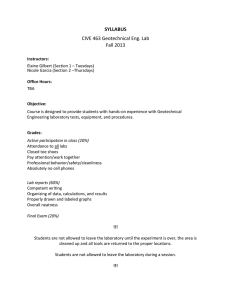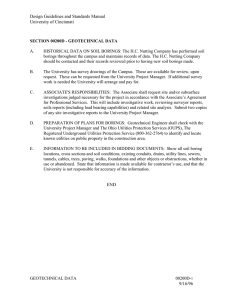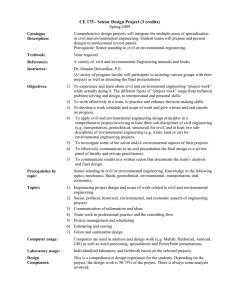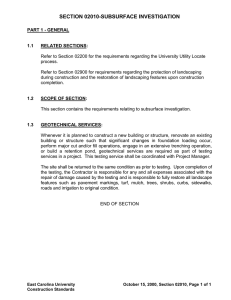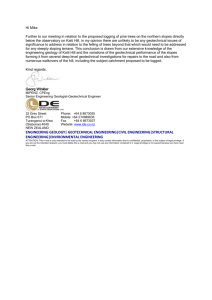Predicting Ground Subsidence Induced by
advertisement
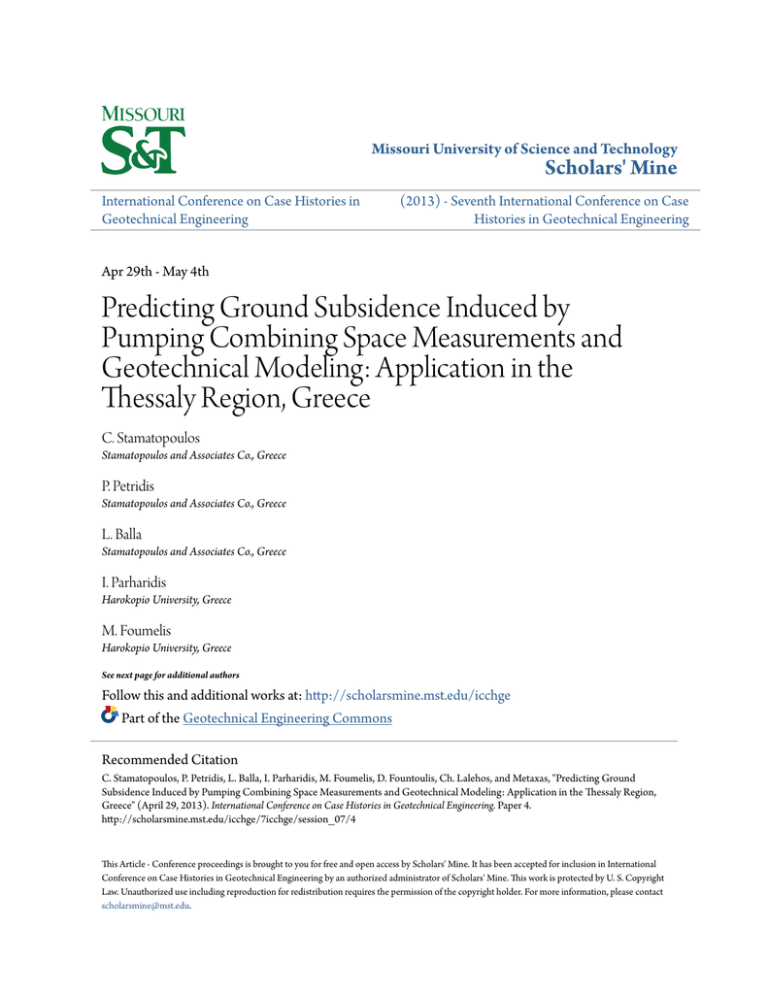
Missouri University of Science and Technology Scholars' Mine International Conference on Case Histories in Geotechnical Engineering (2013) - Seventh International Conference on Case Histories in Geotechnical Engineering Apr 29th - May 4th Predicting Ground Subsidence Induced by Pumping Combining Space Measurements and Geotechnical Modeling: Application in the Thessaly Region, Greece C. Stamatopoulos Stamatopoulos and Associates Co., Greece P. Petridis Stamatopoulos and Associates Co., Greece L. Balla Stamatopoulos and Associates Co., Greece I. Parharidis Harokopio University, Greece M. Foumelis Harokopio University, Greece See next page for additional authors Follow this and additional works at: http://scholarsmine.mst.edu/icchge Part of the Geotechnical Engineering Commons Recommended Citation C. Stamatopoulos, P. Petridis, L. Balla, I. Parharidis, M. Foumelis, D. Fountoulis, Ch. Lalehos, and Metaxas, "Predicting Ground Subsidence Induced by Pumping Combining Space Measurements and Geotechnical Modeling: Application in the Thessaly Region, Greece" (April 29, 2013). International Conference on Case Histories in Geotechnical Engineering. Paper 4. http://scholarsmine.mst.edu/icchge/7icchge/session_07/4 This Article - Conference proceedings is brought to you for free and open access by Scholars' Mine. It has been accepted for inclusion in International Conference on Case Histories in Geotechnical Engineering by an authorized administrator of Scholars' Mine. This work is protected by U. S. Copyright Law. Unauthorized use including reproduction for redistribution requires the permission of the copyright holder. For more information, please contact scholarsmine@mst.edu. Author C. Stamatopoulos, P. Petridis, L. Balla, I. Parharidis, M. Foumelis, D. Fountoulis, Ch. Lalehos, and Metaxas This article - conference proceedings is available at Scholars' Mine: http://scholarsmine.mst.edu/icchge/7icchge/session_07/4 PREDICTING GROUND SUBSIDENCE INDUCED BY PUMPING COMBINING SPACE MEASUREMENTS AND GEOTECHNICAL MODELING: APPLICATION IN THE THESSALY REGION, GREECE C. Stamatopoulos Stamatopoulos and Associates Co Greece, info@saa-geotech P. Petridis Stamatopoulos and Associates Co Greece info@saa-geotech L. Balla Stamatopoulos and Associates Co Greece info@saa-geotech I. Parharidis Harokopio University Greece parchar@hua.gr M. Foumelis Harokopio University Greece parchar@hua.gr D. Fountoulis Earthquake Planning and Protection Organisation of Greece (EPPO) Greece S. Lalehos Earthquake Planning and Protection Organisation of Greece (EPPO) Greece Ch. Metaxas Earthquake Planning and Protection Organisation of Greece (EPPO) Greece ABSTRACT Space technology is a new technology that provides cost-effective measurements of past displacement data. Based on these displacement measurements, within the framework of the European Space Agency’s GMES Terrafirma Project, an improved geotechnical design approach is proposed combining geotechnical modelling and space measurements to predict ground subsidence induced by the lowering of the water table. Then the proposed methodology is applied to predict future displacement at the Thessaly plain - Carla region, Greece due to excessive pumping. 1. INTRODUCTION In many regions in Greece, Italy, Spain, Mexico, Iran, ground subsidence has recently been observed and measured (OrtizZamora, 2010, Rahmanian, D., 1986, Novali et al, 2006, Raucoules et al. 2003, Stramondo et al 2008, Teatini et al, 2007, Tomas et al, 2005. This subsidence varies depending to the region, from a few centimeters (e.g. in Rome) to tens of centimeters (e.g. in Thessaly plain, Greece). Although attempts of explaning the phenomeon include movement of active faults, most researchers believe that this subsidence is caused by water level lowering, that is usually but not necassarily caused by pumping (Bear, 1981, Toufigh and Shafiei, 1996, Toufigh and Qmarsi, 2002, Ouria and Toufigh, 2010). Differential interferometry radar (DInSAR) has proven an interesting tool for the measurement and observation of ground deformation (Hanssen, 2001). The basic idea of the Paper No. 7.02b method is the analysis of the phase of the reflected wave radar from two or more pictures which cover the same region to observe ground displacement. Basically, the phase represents the time needed for the signal to cover the distance from the satellite to the earth surface and return. The difference represents the difference in the distance covered and can be interpreted as displacement at the ground surface. The relatively small cost in the application of the method relative to the conventional ground methods of geodesy, and the ability to retrieve past displacement data, has allowed the application of the method in a number of scientific fields in which the information of ground displacement is needed. Indeed, from 1992 the conventional interferometry has been used in the study of natural phenomena which cause ground movement such as earthquakes, volcanoes, landslides and settlements which have direct economic and environment consequences (Le Mouélic et al., 2002; Raucoules et al., Stramondo et al., 2008). 1 As a result of the limited ability of the conventional interferometry to observe movements which do not exceed about 28 mm, in combination with the effect at the wave, especially from the atmosphere and the ionosphere, improved methods were developed to obtain more accuracy, decreasing also the effect of the factors producing error. Towards this direction, the method of interferometry of fixed reflectors (PSInSAR or PSI) (Ferretti et al., 2000, Pratti, 2010) was developed. The method PSI uses only point locations in which the characteristics of the reflections of the signals radar are not considerably affected from the geometry of the receiver and from other factors affecting scattering, giving high values of relevance and phase. Using only the specified reflectors, analysis is performed of the different phases eliminating the undesirable factors affecting the signal and allowing the estimation of linear and nonlinear rates of ground movement. The PSI method utilizes the rich data base of satellite radar scenes from different satellites. The most important advantage of the method is the ability to construct maps of yearly rates of ground displacement or the change to the rates. The reflectors are located during the processing of the data and cannot be located a priori. In urban regions typically the number of reflectors is 200-600 points/km2. With the assistance of specific software, the response of different phases is analyzed in each reflector, in order to remove the undesirable effects, primarily as a result of the atmosphere, the topography and the curvature of the earth and predict ground movement with sub millimeter accuracy. Geotechnical engineers are called by public agencies and by private owners to asess the risk of this ground subsidence. Prediction of ground subsidence and comparison with tolerable settlements of the structures affected by this subsidence are needed for this purpose. The geotechnical engineers typically predict future displacements using the following procedure: a. Propose a geotechnical model simulating the displacement accumulation for the problem under consideration. Estimate the parameters of the model based on available geotechnical data. b. Use the validated model and parameters to predict future ground displacement. This ground subsidence by the assumption that it is caused by water table lowering is typically predicted using onedimensional consolidation theory (Lambe and Whitman, 1969). Ground displacement past data is not usually used in ground subsidence predictions, as it is usually not available, or thought to be not available. Ground measurements from space is a new technology that provides cost-effective measurements of past displacement data (Le Mouélic et al., 2002; Raucoules et al., 2003; Tomas et al., 2005; King et al., 2007; eatini et al., 2007; Bell et al., 2008; Stramondo et al., 2008). Based on these displacement measurements an improved geotechnical design approach can be proposed to. predict future ground subsidence. It includes the following steps: 1.The proposal of Paper No. 7.02b geotechnical model simulating the displacement accumulation for the problem under consideration. The estimation of the parameters of the model based on available geotechnical data. 2. The validation of the proposed geotechnical model and/or its parameters by the prediction of the past ground displacement data. The adjustment of the model or the model parameters where necessary. 3. The use of the validated model and parameters to predict the future ground displacement under different loading scenarios. It can be noted that this improved design approach is particularly advantageous in the case of ground subsidence induced by the lowering of the water table line. The reason is that (i) the properies of the soils above the underlying rock, that can extend at much depth below the ground surface, that can be hundreds of meters, affects the results and (ii) the soil properties are usually not known with confidence at large depths, as existing geotechnical borings usually do not extend to a depth greater than about 20m, The objective of the paper is to develop and validate a methodology combining (a) space measurement of past displacement and (b) geotechnical modelling of displacement to predict ground subsidence caused by water level lowering. To reach this objective the following are needed and are performed below: (a) develop a geotechnical model and (b) validate the methodology by a case study. 2. PROPOSED GEOTECHNICAL MODEL It is recommended that the geotechnical model predicting settlements induced by lowering the water table is not very elaborate. Numerical effort must not be very large as simulation of different loading scenarios to predict future response must be performed. In addition, unlike other materials, such as steel and concrete, soil properties vary a lot not only in absolute value, but also with location. Furthermore, they are known less certainly, as soil testing, when it is performed, covers a very small portion of the total volume of the material. This is particularly the case in the present application that usually deals with soil extending at much depth below the ground surface, that can be hundreds of meters and where soil properties are usually not known with confidence as existing geotechnical borings usually do not extend to a depth greater that about 20m. Based on the above, the following assumptions are taken: (a) the problem is one-dimensional in space, as only variations versus depth are considered, (b) the constrained modulus of the soil increases linearly with effective stress, (c) the time evolution of settlement is predicted by the one-dimensional consolidation theory, (d) clay layers only contribute to settlement, (e) soil is normally consolidated (OCR=1) and (f) settlement accumulates only when the water table level falls. Assumption (a) greatly simplifies the problem. More complex problem is not justified according to the discussion above. Assumptions (b)-(e) are based on the facts well-known in geotechnical engineering (Kavvadas, 1992, Lambe and 2 Whitman, 1969, Τerzaghi, 1943, Taylor, 1948, Stamatopoulos and Kotzias, 1985) that (i) the constrained modulus of the soil increases linearly with effective stress, (ii) clays are much more compressible than sands or rock, (iii) soils at depths larger than about 10m, that are the depths considered in the present study, are usually normally-consolidated and (iv) settlement during 1-dimentional loading is about 5 times larger than settlement during unloading and reloading. effective stress for shallow depths (1-20m) where field measurements of SPT are taken, of 100kpa. Thus, ki =Ds/100 (6) The change in vertical stress in the current case is due to water level lowering therefore it is given as : Δσ'v = γw ΔΗw As it is assumed that the constrained modulus in each layer (Di) increases linearly with the effective vertical stress σ', we can write (ki σ') dε = dσ' or ln σ' = ki ε or (1) log σ' = 0.43 ki ε ki = 2.3 (1+eo)/ Cci (2) Two methods for the estimation of ki are considered: (a) estimation of the coefficient of compressibility using empirical equations and (b) estimation of the parameter ki in terms of an expression that has been proposed for the constrained modulus. In particular, in case (a) Cc is estimated as Cc = 0.00058 WL + 0.411 e – 0.156 where γw the average unit weight of the water and ΔΗw the water level fall. The time progress of the settlement is predicted by the one-dimensional consolidation theory predicts cv where ki a material parameter for each layer. The parameter ki can be related to the well-known coefficient of compressibility of the soil layer (Cci) as (7) 2 z 2 dt (8) where z is the depth, t is time and cv is the coefficient of consolidation. 3. NUMERICAL SOLUTION OF THE GEOTECHNICAL MODEL Each compressible soil stratum is divided into n layers of equal thickness. In addition, the time is devided in intervals. Solution is obtained for each time where the water table falls between adjacent layers and all solutions were added using superposition. A FORTRAN -77 computer program was written by Mr Petridis to calculate settlement variation with time for given water table variation versus time and soil properties. (3) The total settlement of case (a) above is estimated as where n e = 2.7 ( WL / 100) - Cc log (σ'v / 7 ) (4) where σ'v is the effective vertical stress in kPa and WL is the liquid limit of the soil. Equation (3) has been given by Bowles (1997) and equation (4) by Lopez – Caballero et.al (2007). Equation (3) is preferred from other empirical expressions predicting Cc because it relates Cc to e and varies (decreases) with depth, an important fact in our present study, that concerns very deep layers. Combination of equations (3) and (4) can predict both e and Cc. In case (b) an expression proposed by Stroud and Butler (1975) relating the modulus of compressibility Ds to the field measured quantity of the blow count at the SPT test, NSPT as Ds= f NSPT (5) where the factor f is given in terms of PI in Fig. 1 is used. Then, the factor ki is obtained from Ds assuming a typical Paper No. 7.02b s= C 1 eci i 1 log oi ' voi ' vi zi ' voi (9) where σ'voi is the initial vertical stress at sub-layer i of the compressible stratum, Δσ'vi is the additional vertical stress at layer i equal to the sum of vertical stress increase due to water level fall from layer m+1 and below, CCi is the coefficient of compressibility at layer i, eoi is the void ratio of soil of layer i, Δzi is the thickness of layer i. For the method of the modulus of compressibility the settlement is predicted as: 'vi z i i 1 ' vi k i n s= (10) The solution of equation (8) depends on boundary conditions. Two basic cases of boundary conditions exist: (a) that of drainage at one end and the other being impermeable and (b) that with drainage at both ends. In the case of drainage at one end, the average degree of consolidation, according to 3 Terzaghi's consolidation theory (Dun et al, 2000, Lambe and Whitman, 1969, Τerzaghi, 1943, Taylor, 1948), is predicted as 2 M2 e M T ( t ) Uc = 1 2 U where 0 (11) Μ= (2μ+1) , 2 Tυ = cv H2 t where H is the drainage path, that equals at the height of the layer. For drainage at one end equation (4) can again be used by simply correcting the drainage path, as (H/2). Fig. 1. Estimation of Es from PI, NSPT for clay (Stroud and Butler, 1975). 4. THE CASE CONSIDERED The Karla region within the Eastern Thessaly basin in Greece, was selected due to the significant observed soil settlements due to excessive pumping and the relative availability of water table variation data and geotechnical (even though scarce) data. A map of the wider area of Thessaly plain and of the Karla region are shown in Fig. 2. The effect of settlements at certain sites is shown in photos presented in Fig. 3. The problem appears in form of lengthy cracks or settlemets at many sites. There is great need to predict future settlement in the region in order to decide possible relocation of villages and/or application of mitigation measures. More specifically, the subregion of Stefanodikio in Karla was selected for the precent study. Systematic lowering of the water table of the region begins between 1981 and 1984. In Stefanodikio, water levels fall is as shown in the figure 4, according to measurements reported by the Greek Institute of Geology & Mineral Exploitation (IGME, 2007). Since consolidation settlements take place all over the depth of the basin, soil profiles from deep borings are of interest. Such borings found in the region are only those for water drilling without detailed description, no field tests and no laboratory tests. A number of 29 deep borings of this type Paper No. 7.02b with minimum depth over 50 m (many of them over 100m) were provided by Water Department of Thessaly (2005-2010) and by Mr G. Danos (2005-2010). They illustrate that depth of rock generally lies between 200m and 300m with emergence of rock in shallower depth at certain sites. In Stefanovikio area the depth of rock is estimated at 215m. The general soil composition consists of clay strata (containing silt, sand and (or) gravel) of variable thickness up to 80m, separated by non cohesive layers of sand and (or) gravel or layers of clayey schist, marl (of significant thickness at places) and other thin rock formations. Fig. 5 gives typical borings logs of the regions of the present study. A number of geotechnical borings were found in the wider area of the Karla region by the Central Laboratory of Pulic Works of Greece (Kede, 1963, 1964, 1966, 1973) and the Greek Institute of Geology & Mineral Exploitation (IGME, 2007). As is common practice, geotechnical borings extended to shallow depths and in no case exceeding 30m. Some field and laboratory tests results exist in these borings. In the region of E.Thessaly basin the identified borings are 19. From them 1 is in Chloi village, 1 in Petra of Karla Lake, 2 in Karla bridge, 6 in Karla ditch to the central-east of the basin, 7 in the Platikampos area (Platikampos dam) and 2 in Kastri. No geotechnical borings with sample taking were found in Stefanovikio. Field data available concern SPT while laboratory data include primarily classification tests, (grain size distribution, Atterberg limits). Also some consolidation test parameters e, Cc, cv are given. By processing these data for Karla region the following average values of the blow count of the Standard Penetration test (N SPT), Water Limit (WL) and Plasitity index were obtained to apply all over depth: N'SPT=17.5 , W'L=56.5, PI' = 35.8. 5. APPLICATION: SPACE MEASUREMENTS Deformation measurements from satellite image recordings processed according to PSI method for Thessaly covers the period 1992-2010. Since there are no measurements exactly at the positions of interest, the values of deformations at them are to be estimated from the nearest point measurements. Taking into account points at the vicinity of borings at Stefanovikio and averaging it is observed that the rate of settlement is about 0.0185m/year. Thus, the total settlement from 1992 to 2010 equals 0.333 m. 6. APPLICATION: CALIBRATION OF THE GEOTECHNICAL MODEL Based on the borings logs of Fig 5, Fig. 5 presents the equivalent idealized soil cross-section at the site considered. It also gives the clay layers assumed in the analysis and their drainage conditions. The values of all geotechnical parameters are constant for the design geotechnical section, that means in all compressible clayey strata the same values are used 4 average values of NSPT, WL, PI given above were used to estimate Cc and Ds. The unit weight of the soil was uniformly taken equal to 20kN/m3. The unit weight of water was taken as 10 kN/m3. (a) Stefanovikio Niki (b) Platikampos Fig. 2. (a) Eastern Thessaly accretional basin and (b) Karla region. S1 indicates the site under study. Notations (Γ_, Ε_) indicate geotechnical borings. All other notations (K_ , ....) indicate piezometer positions. Paper No. 7.02b Fig. 3. Photos illustrating the effect of ground displacement at certain sites 5 of the settlement for the second method and the two c v values, agreement is very good: the ratio of measured to predicted total settlement equals 0.98. 7. APPLICATION: PREDICTION OF FUTURE SETTLEMENT Fig. 4. Measured water table fall for Stefanovikio region 19832010. Assumed water table fall for 2010-2020 under the two studied scenarios. Finally, the value of consolidation coefficient c v was selected. A single value for all the clayey strata was considered. Only in one boring in Kastri village, cv was measured in the laboratory. The average value equals 7.4x10-3cm2/sec = 7.4x10-7m2/sec. This is a low value. It has been established that actual cv values in the field could be much higher, even 1000 times those measured in the laboratory (Stamatopoulos and Kotzias, 1985).This is due to the non homogenious clayey material. Indeed borings show the presence of sand within the clayey strata, that may greatly increase the c v value, as flow will occur thru the permeable material. From available data it is impossible to reliably select a representative value of c v. For this reason two limiting values are considered: cv min = 7.4x107 2 m /sec and cv max = cv min x 1000=7.4x10-4m2/sec. Based on the above, the two methods for settlement estimation were applied for the idealized section (Fig. 5). One parameter in the model was considered to vary, that is the c v factor, to which the two limiting values 7.4x10-7, 7.4x10-4 m2/sec were assigned. Ground water level fall is applied according to Fig. 4. Water level fall step is taken equal to 2m. Time step is 180 days and period of study for which settlements are calculated for 50 years. For these input values the settlement results are presented in Fig 6. Differential settlement between year 9 and 27, that is of interest for comparison with measurements, is given for both cases in Table 1. By assuming that satellite recordings measurements are generally reliable the following remarks can be made: The second method of calculation produces results closer to reality. By comparing these results with the satellite measurements a further evaluation of the model results can be made: the actual value cv of the consolidation coefficient lies between the end values cv1, cv2, that is very reasonable. So, the parametric analysis with respect to cv show that a proper value of cv between limiting values cv1, cv2 has to be selected. Comparison of derived results with satellite based measurements of Table 1 shows that, taking the average value Paper No. 7.02b According to the above analysis, the second method gives results comparable to space measurements. In particular, in order that predicted values agree with the measured ones, the average value of settlement of cv1 and cv2 is considered in the predictions. Two cases are distinguished with respect to water table fall in the future. In the first case (case I) stabilization of water level occurs at the present time (T w=27years). In the second case (case II), continuation of water level lowering occurs till 2020 and stabilization at that time (T w=37). The two cases are illustrated in Fig. 4. Settlement predictions for these two cases are given in Fig. 7. It can be seen that the increase in final total settlement due to water table fall in the decade 2010-2020 is relatively small compared to this settlement itself for the period 1983-2010 (about 8%). This is reasonable given that this fall affects only a part of the clayey strata and indeed those lying in lower depths where compressibility is lower. Despite of this, the corresponding increase in estimated total settlement between years 2010-2020 for case 1 appears to be much higher proportionally, or about 40%. This is due to the fact that settlement initiated by the new water table lowering has a consolidation rate, that is much higher than the corresponding rate of the continuing consolidation process due to water table lowering between years 1983-2010. Furthermore, in absolute values, additional settlement after 20 years in the first case is in the order of 10-15cm, while in the second case 5-9cm. The first case is not tolerable for new regular houses, while the second can be tolerable. It is inferred that considering that a settlement of 0.05m is tolerable, this means that stopping water table lowering may mitigate the settlement problem for new houses. Table 1. Computed settlement (in m) in the period of the space measurements for the two methods. Corresponding measured displacements are also given. Δs 9,27 Method of Cc cv1 cv2 0.80 1.47 Method of Ds cv1 cv2 0.23 0.43 Measured 0.33 6 (a) (a) t (years) (b) 0 5 10 15 20 25 30 35 40 45 50 55 60 0.0 Stefanovikio η 1 boring (Tragana) Stefanovikio η 2 boring (Tragana) 1.0 2.0 Method of Cc Method of Ds 0.0 0.0 Clay 16 3.0 Clay+sand 33 Clay Alouvial deposit 54 62 4.0 Sand Clay+sand 5.0 84 s(t) (m) flysch 120 (b) 130 t (years) fluvial formations(red clays and clayey-sandy material) limestone with fault 0 5 10 15 20 25 30 35 40 45 50 55 60 0.0 204 1.0 250 2.0 (c) (d) Stefanovikio η 3 boring (Sifritzali) 3.0 4.0 Method of Cc Method of Ds 5.0 s(t) (m) 0.0 Clay Fig. 6. Prediction of settlement at site S1. for (a) cv=7.4x104 2 m /sec and (b) cv=7.4x10-7m2/sec (a) 80 Clayey schist 100 t (years) Clay 115 0 Clay with gravel 145 5 10 15 20 25 30 35 40 45 0.2 172 180 Clay Gravel 55 60 WT case 1 WT case 2 Gravel 160 50 0.0 0.4 0.6 Clay in alternation with clayey schist 208 0.8 Gravel with cobbles 1.0 221 Clay 255 Gravel 270 281 290 1.2 s(t) (m) Clay with marl Limestone (b) Marly limestone 306 t (years) 0 Fig. 5. (a-c) Geotechnical section of soil in Stefanovikio at hydrolic borings S1, S2, S3 (locations indicated in Fig. 2). (d) equivalent idealized soil cross-section. Black line means that drainage is not permitted. Else drainage is allowed 5 10 15 20 25 30 35 40 45 50 55 60 0.00 0.05 WT case 1 WT case 2 0.10 0.15 0.20 Δs(t) (m) Fig. 7. Prediction of future settlement at site S1 (a) total settlement with time, (b) future (after 2010) settlement with time. Two cases are distinguished with respect to water table fall in the future. In the first case (case I) stabilization of water level occurs at the present time (Tw=27years). In the second case (case II), continuation of water level lowering occurs till 2020 and stabilization at that time (TW=37years). Paper No. 7.02b 7 8. CONCLUSIONS Space technology is a new technology that provides costeffective measurements of past displacement data. Based on these displacement measurements an improved geotechnical design approach can be proposed. It includes the following steps: 1.Propose a geotechnical model. Estimate the parameters of the model based on available geotechnical data. 2.Validate the proposed geotechnical model and its parameters by the prediction of the past ground displacement data. Make adjustment of model or model parameters where necessary. 3. Use the validated model and parameters to predict ground displacement. Based on the above, the paper develops a geotechnical model predicting ground subsidence induced by pumping to be used with the proposed methodology. The developed methodology is then applied to predict future displacement at the Stefanodikaio village in Thessaly plain, , Greece due to excessive pumping. Water table level lowering was assumed to continue with the existing rate (1m/year) till 2020 or to cease at present (2010). The increase in final total settlements in the latter case was found to be relatively insignificant (less than 8% in any site) but the increase in period 2010-2020 as compared to settlements at 2010 is indeed significant (40%). In absolute values, the total settlements in the latter case in the period 2010-2020 is about 0.05-0.09m compared to 0.14-0.09m. Considering that a settlement of 0.05m is tolerable, this means that stopping water table lowering may mitigate the settlement problem for new houses. ACKNOWLEDGEMENT This study was conducted within the framework of the Terrafirma Project, which is supported by the European Space Agency under the GMES Service Element Program. Terrafirma is a pan-European geo-hazard information service (www.terrafirma.eu.com). REFERENCES Bell, J. W., Amelung, F., Ferretti, A., Bianchi, M. & Novali, F., 2008. Permanent scatterer InSAR reveals seasonal and long-term aquifer-system response to groundwater pumping and artificial recharge. Water Resources Research, 44, W02407. Bowles J.E., 1997, Foundation Analysis and Design, Mc Graw-Hill, Ch. 2, pg. 89. Central Laboratory of Pulic Works of Greece (KEDE) (1963, 1964, 1966, 1973) Boring reports No 137, 145, 484, 653 and of Larisa Platikampos Dam Danas G. (2005-2010) Water borings in Larissa Prefecture (private communication) Thessaly water department (2005-2010), water borings in Larissa Prefecture (private communication) Paper No. 7.02b Ferretti, A., Pratti, C. & Rocca, F. (2000). Nonlinear subsidence rate estimation using Permanent Scatterers in differential SAR interferometry. IEEE Transactions on Geoscience and Remote Sensing, 38(5), 2202-2212. Greek Institute of Geology & Mineral Exploitation (IGME) (2007) Technical-geological investigation of subsurface soil cracks in areas of Thessaly Greek Institute of Geology & Mineral Exploitation (IGME) (2007). Investigation of hydrogeolical conditions in areas of Larisa and Magnisia, with soil cracks phenomena Hanssen, R. F., 2001. Radar Interferometry: Data interpretation and error analysis. Kluwer Academic Press, Dordrecht, The Netherlands, 298p. Kavvadas M. (1992). Geotechnical engineering. National Technical University of Athens, 298 pages King, N. E., Argus, D., Langbein, J., Agnew, D. C., Bawden, G., Dollar, R. S., Liu, Z., Galloway, D., Reichard, E., Yong, A., Webb F. H., Bock, Y., Stark, K. & Barseghian, D. (2007). Space geodetic observation of expansion of the San Gabriel Valley, California, aquifer system, during heavy rainfall in winter 2004–2005. Journal of Geophysical Research, 112, Le Mouélic S., Raucoules D., Carnec C., King C., and Adragna, F (2002). A ground uplift in the city of Paris (France) detected by satellite radar interferometry, Geophysical Research Letters, 29(17), 34-1. Lambe T., Whitman R., 1969, Soils Mechanics, John Wiley & Sons, Ch. 12, pg. 156-157, Ch. 19, pg. 290, Ch. 27, pg. 407. Lopez-Caballero F., Modaressi A., Modaressi H. “Nonlinear numerical method for earthquake site response analysis I – elastoplastic cyclic model and parameter identification strategy”, Bull Earthquake Eng (2007) 5:303 – 323. Ortiz-Zamora Dalia, Ortega-Guerrero Adrian. 2010. Evolution of long-term land subsidence near Mexico City: Review, field investigations, and predictive simulations. WATER RESOURCES RESEARCH, VOL. 46., Ouria Ahad,. Toufigh Mohammad M , Prediction of Land Subsidence Under Cyclic Pumping Based on Laboratory and Numerical Simulations. 2010. Geotechnical and Geological Engineering Volume 28, Number 2, 165-175 Parcharidis, E. Lagios, V. Sakkas, D. Raucoules, D. Feurer, S. Le Mouelic, C. King, C. Carnec, F. Novali, A. Ferretti, R. Capes, and G. Cooksley (2006) Subsidence monitoring within the Athens Basin (Greece) using space radar interferometric techniques. Earth Planets Space, 58, 505–513, Raucoules, D., Le Mouélic, S., Carnec, C., Maisons, C., and 8 King, C. (2003). Urban subsidence in the city of Prato (Italy) monitored by satellite radar interferometry, International Journal of Remote Sensing, 24 (4), 891-897. Stamatopoulos A.C., Kotzias P.C., 1985, Soil Improvement by Preloading, John Wiley & Sons, Ch. 4, pg. 105. Stramondo, S., Bozzano, F., Marra, F., Wegmuller, U., Cinti, F. R., Moro, M. & Saroli, M., (2008). Subsidence induced by urbanisation in the city of Rome detected by advanced InSAR technique and geotechnical investigations. Remote Sensing of Environment, 112, 3160–3172. Stroud, M.A. & Butler, F.G., 1975, The Standard Penetration Test and the Engineering Properties of Glacial Materials, Proc. Symp. On Engineering Properties of Glacial Materials, Midlands Geotechnical Society, Birmigham. Taylor D.W. (1948). Fundamentals of Soil Mechanics, Wiley. Teatini P., Strozzi T., Tosi L., Wegmuller U., Werner C., Carbognin L., Rosselli R., Cecconi G., Giada M. (2007). ERS and envisat SAR interferometry to measure land subsidence in the venice lagoon on natural and artificial point targets”, European Space Agency, (Special Publication) ESA SP, Issue SP-636 Τerzaghi K. (1943). Theoretical soil mechanics. John Wiley & Sons Inc Tomas, R., Marquez, Y., Lopez-Sanchez, J. M., Delgado, J., Blanco. P., Mallorqui. J. J., Martinez. M., Herrera. G. & Mulas. J., (2005). Mapping ground subsidence induced by aquifer overexploitation using advanced Differential SAR Interferometry: Vega Media of the Segura River (SE Spain) case study. Remote Sensing of Environment, 98, 269-283. Toufigh, M.M. and B. Shafiei, 1996. Finite element consolidation model for subsidence problem based on biot's three dimensional theory. Int. J. Rock Mech. Mining Sci. Geomech., 33: 344-354. Paper No. 7.02b 9
